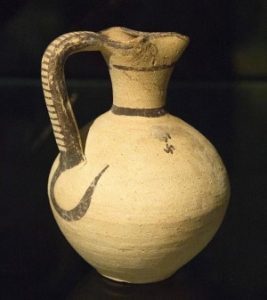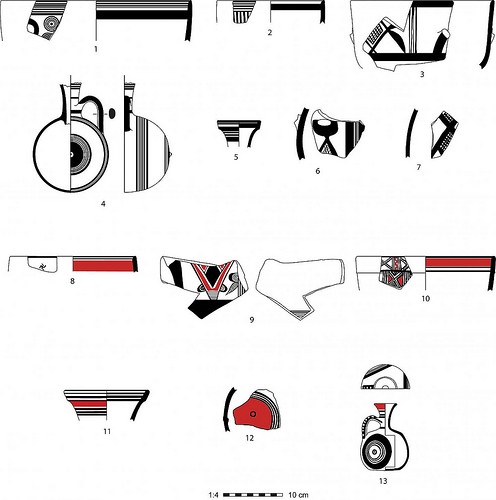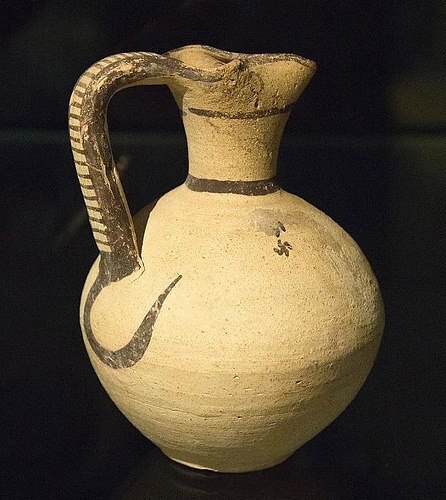
PLOS—Cypriot-style pottery may have been locally produced as well as imported and traded in Turkey during the Iron Age, according to a study* published November 30, 2016 in the open-access journal PLOS ONE by Steven Karacic from Florida State University, USA, and James Osborne of the University of Chicago, USA.
White Painted and Bichrome Wares are Cypriot-style ceramics produced during the Iron Age that may provide clues about trade in the Eastern Mediterranean at that time. Although these ceramics are often assumed to be imports from Cyprus, excavations in southern Turkey have suggested that some pottery was produced locally, challenging previous assumptions about trade in the Eastern Mediterranean.
The authors of the present study analyzed White Painted and Bichrome Wares recovered from three sites in the Hatay region of Turkey: Tell Tayinat, Çatal Höyük, and Tell Judaidah, using techniques which bombarded the pottery with x-rays and neutrons, providing insight into the chemical elements they contained. Imported and local versions of this pottery had different elemental compositions, which helped the authors determine where this pottery was produced. When compared with existing datasets, the researchers found that Çatal Höyük and Tell Judaidah may only have had access to pottery imported from Cyprus whereas Tell Tayinat may have made Cypriot-style pottery locally as well as importing it.
________________________________________
Cypro-Geometric III and Cypro-Archaic I (ca. 850-600 BCE) pottery from Tell Tayinat, ancient Kunulua.
(1-3) White Painted Ware vertical-sided bowls; (4-7) White Painted Ware barrel jugs; (8-10) Bichrome Ware vertical-sided bowls; (11-12) Bichrome Ware barrel jugs; (13) Bichrome Ware juglet. Credit: Karacic et al (2016)
_____________________________________________________
Example of a white painted ware IV ancient Cypriot jug, 7th century BC. Zde, Wikimedia Commons
____________________________________________________
The authors suggest that feasting practices amongst the affluent in Tell Tayinat may have driven demand for Cypriot-style pottery, resulting in either local potters producing this pottery or Cypriot potters settling in the vicinity. Usually, pottery styles are expected to become increasingly rare the further away they are found from their origin of production, so these findings suggest a complex pattern of exchange in the Eastern Mediterranean during the Iron Age.
“We were surprised to find that locally produced Cypriot-style pottery was consumed at Tell Tayinat but not the other sites included in our study,” says Karacic. “These results indicate complex social and economic interactions between the Amuq and Cyprus that we are only just beginning to understand for the Iron Age.”
Article Source: PLOS news release
______________________________________________________
*Karacic S, Osborne JF (2016) Eastern Mediterranean Economic Exchange during the Iron Age: Portable X-Ray Fluorescence and Neutron Activation Analysis of Cypriot-Style Pottery in the Amuq Valley, Turkey. PLoS ONE 11(11): e0166399. doi:10.1371/journal.pone.0166399
______________________________________________________
Subscribe to Popular Archaeology Premium. Available on all laptops and mobile devices, and still the industry’s best value at only $9.00 annually.
___________________________________________
Travel and learn with Far Horizons.
____________________________________________
This richly illustrated issue includes the following stories: Recent findings shedding new light on the whereabouts of the remains of Philip of Macedon, father of Alexander the Great; how an archaeologist-sculptor is bringing bones of the dead back to life; archaeologists uncovering town life at the dawn of civilization; an exclusive interview with internationally acclaimed archaeologist James M. Adovasio about what makes the Meadowcroft Rockshelter prominent in the ongoing search for the first Americans; what archaeologists are finding at the site of the ancient city of Gath, the home town of the biblical Philistine giant, Goliath; and how scientists are redrawing the picture of human evolution in Europe. Find it on Amazon.com.








